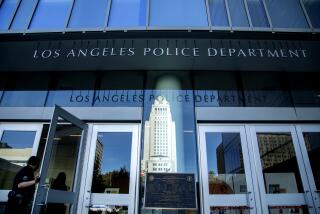Beating Incident Dogs Bradley as He Goes Out Into Community
The crisis over the Rodney G. King beating trailed Mayor Tom Bradley on Thursday as he ventured from City Hall for a daylong sweep through schools, businesses and social service centers in the Harbor area.
It was the mayorâs most extensive public appearance since the March 3 incident plunged the city, its police force and its chief into the center of a national controversy over police practices.
Normally, such âArea Daysâ are little-noticed, parochial affairs that offer Bradley a chance to mingle with constituents, confer with local business leaders about their troubles and visit the myriad community programs funded by the city.
But Thursday the Rodney G. King case kept resurfacing.
It dominated one of the mayorâs first stops at Banning High School in Wilmington.
Before a racially mixed audience of 300 students in the schoolâs auditorium, Bradley fielded question after question--about the beating incident, about the history of police misconduct in the department and about his own experiences as a black Los Angeles Police Department officer in the 1950s and 1960s.
The students applauded when Bradley reiterated his outrage at the conduct of the officers involved in the King case and the need for changes in the department to âget rid of any strain of racial animosity or abuse of police authority.â
Does Bradley think Chief Daryl F. Gates should resign, one student asked.
âOnly he has the authority and ability to say, âI retire,â â the mayor responded. âNo requests are going to make any difference until the chief recognizes that he, by staying on, may be damaging the department. Thatâs a judgment he has to make. I hope that judgment will be made by him in a conscientious fashion.â
Responding to another question, Bradley said there was racism in the Police Department when he was an officer, including a kind of âunwritten rule that no black was ever going to rise to a position higher than lieutenant.â Bradley was the departmentâs first black lieutenant.
Typically, there are no television news crews in sight during the mayorâs routine communityvisits.
But on Thursday they showed up in twos, threes and fours at nearly every one of Bradleyâs 12 stops. Should Gates go? Can the Police Commission remove Gates? Is the mayor going to name a high-level citizens commission to investigate the Police Department, as The Times reported? What about the governorâs remarks in support of the chief?
By midday, the mayor was lagging nearly 45 minutes behind schedule because of all the impromptu news conferences.
While the controversy trailed the mayor, his hosts along the way tried to keep Bradleyâs attention focused on their problems: the redevelopment of the San Pedro waterfront; funding for a proposed trolley through the San Pedro shopping district; and a plan to bring more tourism to the Harbor area to offset the thousands of shipbuilding and other jobs lost in recent years.
Although the news media pursued Bradley throughout the day, the public sometimes displayed little interest in the controversy.
Longshoreman Juan Diaz, who was snapping pictures of the mayor outside his union hall, said the police controversy is not a big deal in San Pedro. âThe police are very well-liked in this area,â he said. âWe have no complaints.â
Jerry Gains, president of a Harbor area homeowners coalition, agreed, noting that the Harbor is miles from Los Angeles and has its own police division. Many see it as their own Police Department, he said. âWeâre very supportive of the police,â he said.
More to Read
Sign up for Essential California
The most important California stories and recommendations in your inbox every morning.
You may occasionally receive promotional content from the Los Angeles Times.










